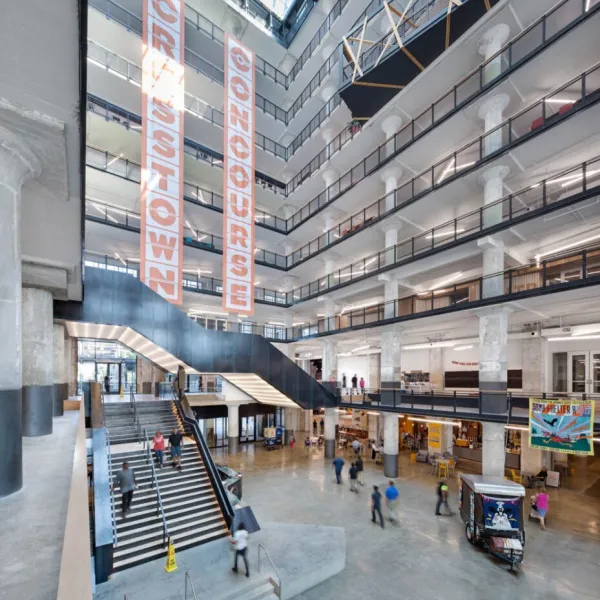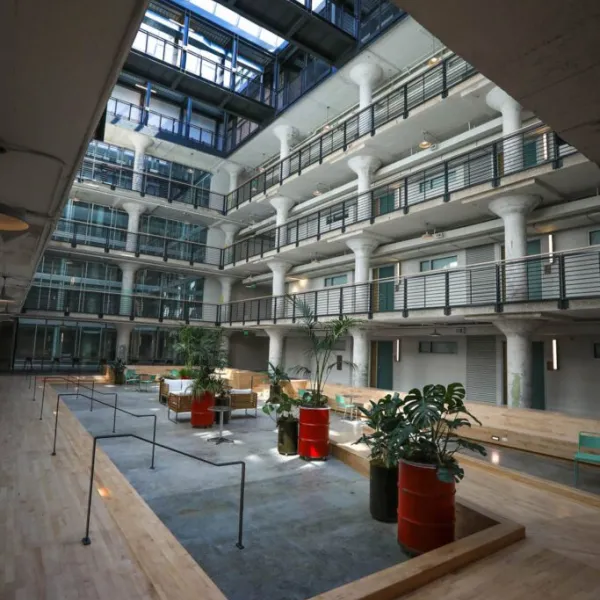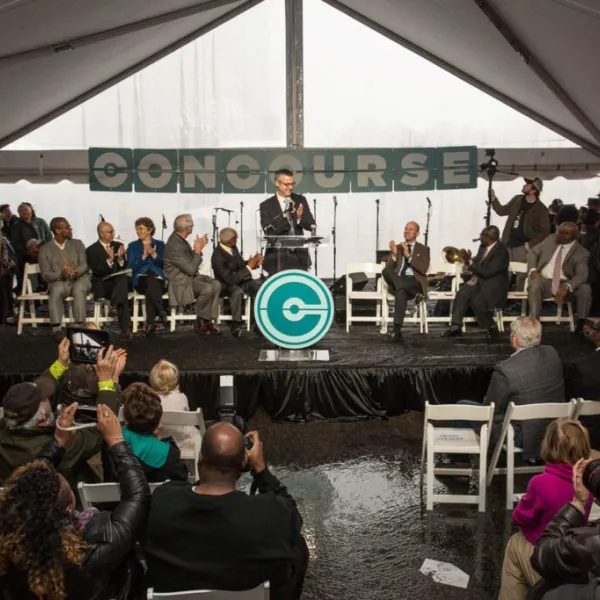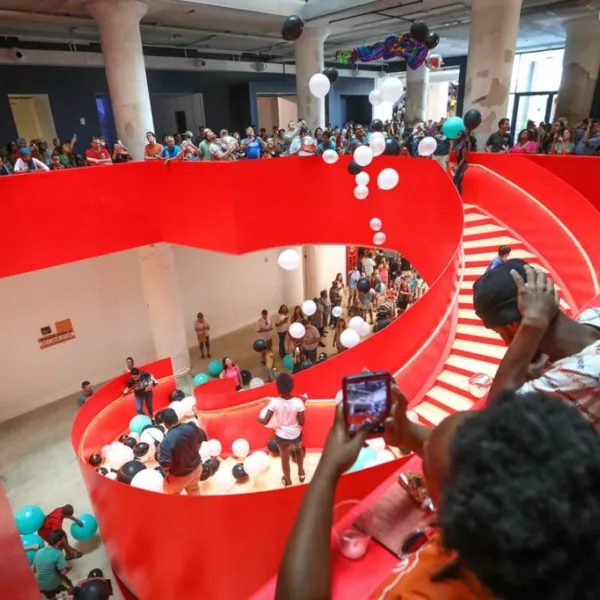Fostering Belonging in Memphis: Crosstown Concourse


The Action
In 2009, a 1.5 million-square-foot Sears Distribution center in Memphis, Tennessee, sat vacant, as it had since 1993. Though there are ten Sears distribution centers in the nation, each building’s preservation story has been different (three have been demolished). Seattle’s Sears distribution center is now the Starbucks Center, the company’s headquarters, and Atlanta’s is the Ponce City Market, a mixed-use building adjacent to the Beltline in Midtown. What is unique about Memphis’ reimagination of its Sears building as a “vertical urban village” by the name of Crosstown Concourse is its grounding in community, health, and the arts. The renovation of such a mammoth building started with a vision and opened its doors eight years and $210 million later with a clear mission “to use a building to change how people experience their lives, their neighborhood, and their city by purposefully creating unexpected connections.”
Democracy Challenge
According to MLK50 and a report by Demos and Organize Tennessee, the state of Tennessee has one of the lowest average election turnout rates in the United States. Shelby County (where Memphis is located) has the second highest number of infrequent voters, defined as “registered voters who have not participated in any of the past three general federal elections”.
As many cities strive to enhance civic engagement to strengthen local democracy, one potential solution is to focus on fostering belonging. A fundamental human need, belonging enables individuals to feel emotionally connected, welcomed, and included. Meanwhile, loneliness, which was officially declared a global epidemic by the US surgeon general and the World Health Organization (WHO) in 2023, is a direct threat to democracy because it intensifies isolation and social disconnection, which can lead to disempowerment and apathy. Considering that democracy requires citizens to participate in their communities and governments, anything that threatens civic engagement, like loneliness, can be a threat to democracy. Therefore, fostering belonging presents an opportunity to address disempowerment and apathy by increasing civic pride and driving local engagement.
How It Works and How They Did It
Leveraging “urban magnets theory”, Crosstown Collaborative (the development team behind the building) began to think about the neighborhood as a larger ecosystem, and this vacant and blighted building served as the heart of an entire neighborhood—Crosstown. In collaboration with the community, the development team and its founding partners created nine guiding principles to serve as a north star to filter decisions throughout the process of development, design, and ongoing operations. For example, one of the guiding principles was that the building should feel “porous”. With 32 entrances and exits, the building prioritized access over control to ensure people felt like they belonged, a process that starts with being comfortable coming and going freely. This idea is further exemplified by security officers who are also trained as concierges who can be welcoming and help visitors, rather than policing the building by questioning who “looks like they don’t belong”.
Crosstown Concourse centered collaboration by first assembling an interdisciplinary team. As one of the visionaries behind the project and now president and CEO of the building Todd Richardson describes it, “The hardest thing about the project was always believability. We knew we could design a beautiful space, but we had to get people to take us seriously.”
This is where the founding partners came in. Whether it was a local nonprofit like Church Health centralizing 14+ buildings into one space, a local network of hospitals consolidating administrative functions, or momentum for new commercial activity in the neighborhood, these partners bought into the vision for a community-serving, mixed-use project and started to think about the value of shared space and integrated design.





When financing this $210 million project, cadence was key. The vision of revitalizing this vacant building into a hub of community, health, and the arts first enticed the founding partners, then their commitment attracted potential investors. Next, the collective financial backing enabled tax incentives, and lastly, the additional sources made it possible for the vision to be completed with additional fundraising. Total sources of funding for the project included public infrastructure upgrades from the City of Memphis and Shelby County, a 20-year PILOT (payment in lieu of taxes) from the Downtown Memphis Commission, historic tax credits and new markets tax credits from the federal government, and 20 additional public, private, and philanthropic sources.
As cities look for models to foster belonging, Crosstown Concourse in Memphis presents an effective demonstration of how public- and private-sector involvement and investment can reimagine a single building as an “intersection of art, life, and civic drive” that strengthens the social fabric of a city.
With partners ranging from a public charter high school to higher education institutions, a YMCA to St. Jude Children’s Research Hospital, art galleries and installations to art-residency programs, Crosstown deepened the delivery of a traditional mixed-use project by placing its partners at the heart of the redevelopment process. The community-grounded mission of the building is further evidenced by the commercial activity, ranging from a traditional craft brewery to a nontraditional café geared towards immigrants and refugees who are food entrepreneurs. The latter is noteworthy for its profit-sharing model and the fact that there is no upfront cost, which reduce the barriers to entry for immigrant chefs. The building therefore thrives in generating creative collisions of musicians, health advocates, teachers, scientists, and Memphis residents coming together and creating connections to their city and each other.
How’s It Going?
From the beginning of the project, the development team always knew success was not the groundbreaking or opening day; it would be the community that had formed around the building 10 years down the line. Eight years into this vision, success is defined as much by metrics as by moments. According to President and CEO Richardson, maintaining occupancy or affordability sometimes feels secondary to seeing people use the building as a background for photoshoots, select the Concourse as a venue for their family reunion, or choose to work from their laptop all day (all without questions, reservations, or fees). All of these activities highlight the success of the building as a place where people feel they truly belong and have no economic barriers to entry.
From the city’s perspective, Crosstown Concourse has been not only a catalyst for development in the neighborhood, but also a hub of health, education, and arts, and a point of pride in how the city honors its past while reimagining its future. All of this is encapsulated in the fact that the head of the Memphis Convention and Visitors Bureau often starts his tours of the city by taking people to Crosstown Concourse. He believes experiencing a building that is owned by its users demonstrates the spirit of a city that belongs to its people.
Considerations
Crosstown Concourse attributes its success to various factors that aligned at the same time not only to make an ambitious project feasible but also to champion a creatively-led process.
- Harnessing Momentum: The development team behind the project was able to build on the infectious excitement in the city around envisioning its next era brought on in part by numerous large-scale development projects in its downtown, playoff appearances by the NBA team the Memphis Grizzlies, and the formation of a viral local campaign to “Choose 901” (the area code for Memphis).
- Leveraging “Patient Capital”: In development, time is money. This means that creative placemaking around the original concept required patient capital. Funders who valued the creative process understood that in-depth discussions with the various voices and constituents were required to ensure the successful adoption of the building by the city and its residents.
- Honoring Your Roots: It is easy to underestimate the role of civic pride, but in the same way that the City of Memphis informed the reimagination of the Crosstown Concourse, the reactivation of the Sears building inspired city residents as well as additional projects in the city.
- Investing in Sustainable Thinking: According to the US Green Building Council, Crosstown Concourse is the largest LEED Platinum-certified historic adaptive reuse project in the world. What is the impact? It means five piles of coal the size of the Eiffel Tower are saved from being burned every single year (totaling more than 40 piles since the building opened its doors).
Point of Contact
Todd Richardson
President and CEO
Crosstown Redevelopment Cooperative Association, Inc.
Email: [email protected]
Who else is trying this?
- Brent Civic Centre (Wembley, UK): Streamlining Wembley Council’s civic and administrative activities while creating new community space for the neighborhood.
- Reimagining the Civic Commons (Akron, Chicago, Detroit, and Memphis, USA): Transforming various civic assets and public parks from places of untapped potential to places that “bridge differences, create increased and more equitably shared prosperity, and contribute solutions to some of the most pressing challenges of our time.”
- Promprylad (Ivano-Frankivsk, Ukraine): Reimagining a Soviet-era plant into a modern innovation center that is designed for the intersections of education, art, new economy, and urbanistics.